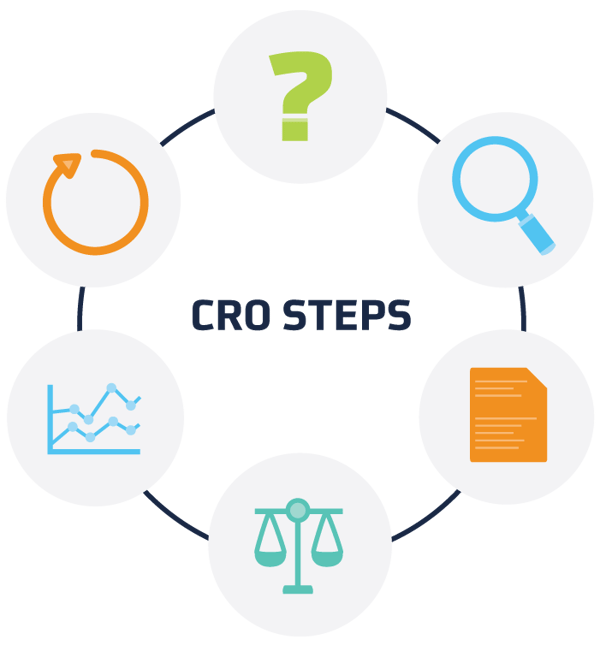To convert website visitors into leads, think conversion rate optimization — or CRO.
It's disheartening when you work hard to create a well thought-through marketing strategy only to experience the same marketing problems as everyone else — like plateauing sales (or worse yet, declining sales), little or no ROI, or a website that consistently fails to convert visitors into leads.
While all of these issues are significant, this blog post addresses — and proposes a way to fix — the later setback.
CRO Addresses Conversion Issues
If your website visitors aren't taking the actions that you want them to take — i.e., signing up for an email newsletter, creating an account with a login and password, requesting a content offer, making a purchase, downloading an app, etc. — it's a conversion problem. If they're not converting from a visitor to a lead, then it's likely they'll never become a customer either.
So, what exactly is CRO and what does it have to do with improving website conversions?
CRO stands for Conversion Rate Optimization. CRO is an offshoot of SEO — it's a part of optimization that focuses solely on the point of conversion or getting a website visitor to take a specific action that leads them further into the buyer's journey or down the marketing & sales funnel.
Like SEO, CRO takes a systematic approach — much like the scientific method — to identify the problem(s) and create solutions.
To serve as an example, here are the steps along with a hypothetical situation from start to finish.

- Ask a question
- "Why aren't people clicking the "Learn More" call-to-action (CTA) button on my latest blog post?" - Do some research
- Look at user behavior and ask: Is this post getting much traction on social channels? How many people are clicking through to read the post? Are readers clicking on other links in the post?
- Look at your most successful past CTAs and ask: What do they say? What color are they? What's their size? Where are they located on the page? - Formulate a hypothesis
- "People are clicking through to read the blog post, so the content must be relevant. I think that readers are not clicking the "Learn More" CTA button because it's not the most helpful or compelling next step for them to take. I should change the CTA to 'Get Checklist Here' and link to a downloadable checklist that supports the content of the post." - Test your hypothesis
- Make a new CTA button for the blog post, then promote the content again. - Analyze the data
- After a designated time (perhaps 1-2 weeks), check analytics. Have more people clicked on the CTA since you changed it? If so, that means your conversion rate, in this instance, has improved. - Repeat!
- If you're happy with this result, great! If not, going back to step 1 and try again — there are more things to test and more potential solutions.
Here are a couple of real-life CRO problems and solutions.
- Problem: Switch Video, a video animation company in Canada, wasn't generating qualified leads through their homepage.
Solution: In this instance, they chose to focus on the main CTA button. After some testing and data review, they discovered that changing a single word on the CTA button worked. Conversions increased by 221%!
- Problem: Performable, a company acquired by HubSpot in 2011, also struggled to get visitors to click on CTA buttons.
Solution: After evaluating the size, shape, wording, and color of the button, they decided it was the color that needed changing. After they made the change from green to red, their click-throughs increased by 21%.
Now, not all solutions are this simple. Sometimes the testing and evaluation takes much longer and is more complicated, but other times it really is as simple as changing a word or swapping colors.
If you would like to see more examples or want more nitty-gritty CRO details, check out The Definitive Guide To Conversion Optimization by QuickSprout.com.
Why Does CRO Matter?
If your points of conversion are not optimized, people are less likely to take action. Which means you won't get leads, let alone the qualified and quantified leads you want. CRO not only helps to increase conversions and ultimately boost sales, but it's also cost-effective because it capitalizes on traffic already coming to your website. And remember — the higher the conversion rate, the better your ROI.
How Can I Implement CRO? Where Should I Start?
For most pain points, there are many variables you can test. In addition to varying button colors and changing CTA copy, you can try different headlines, make new value propositions, and more. Each change has the opportunity to impact conversions.
If you have internal marketing staff, they can handle CRO — or at least learn more about it to implement it themselves. If you don't have the personnel to handle it and you don't have the capacity to do it yourself, consider hiring a marketing agency — like us! — to help you. We're happy to share our knowledge and experience with you so that your website visitors turns into leads which will hopefully turn into customers! Contact us to get the conversation started.

Learn more about our services like branding, website design, digital marketing, and sales enablement. Let's work together to get more leads, close more sales, and grow your business faster!
Subscribe to Our Blog
Stay up to date with the latest marketing, sales, and service tips.



